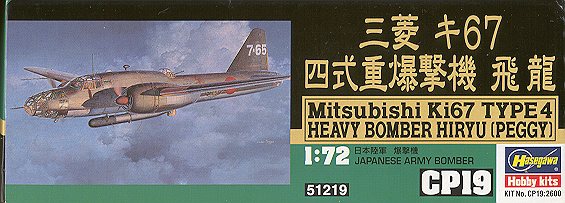
|
KIT: |
Hasegawa 1/72 Ki-67 'Hiryu' |
|
KIT # |
CP 19 |
|
PRICE: |
$26.98 |
|
DECALS: |
See Review |
|
REVIEW & |
|
|
NOTES: |
|

|
HISTORY |
Design of the Ki-67 Hiryu "Dragon Slayer", began in late 1939 with a requirement to Mitsubishi for a fast heavy bomber. The design was approved in early 1941 and Mitsubishi was directed to start work on the prototype. This aircraft was completed in late 1942 and 17 preproduction aircraft were subsequently built. Full production bombers rolled off the assembly line in August 1944.
Due to the changed conditions of the war by that time, nearly all of them were outfitted at torpedo bombers. Unfortuately, the 'Long Lance' torpedoes were too large to fit in the bomb bay so had to be carried externally under the aircraft. Several were also upgraded with warning radars, though this did not apply to all aircraft. Other uses for the Hiryu were as mother ships for the Ohka piloted bombs.
First combat use of the aircraft was in October 1944 by the 98th Group off the coast of Taiwan. Unfortunately for the Japanese, most of their trained bomber crews has already been lost in the years before. The new, poorly trained crews that were left, were unable to effectively use this new bomber. It also didn't help that the Allies had air supremacy over the target.
|
THE KIT |
Hasegawa continues its current trend in 1/72 of releasing kits of Japanese bomber aircraft. The Hiryu is the fifth of the series; the other four being the G4M2 Betty, Ki-49 Helen, G3M2 Nell, and P1Y1 Frances. It seems that they are alternating between Army and Navy bombers. With this being the case, a Ki-21 Sally shouldn't be too far behind!!
 Molding is very
typical of what one would expect from a new mold Hasegawa kit; it is
excellent. Also typical of Hasegawa, the six medium grey sprues are all
packaged together in the same bag. The clear bits and decal sheet are in a
separate bag. Rather than show you a composite of all the spures, I'm going to
start putting up (where appropriate) the parts layout drawing and a
representative section of the kit. As you can see, there are quite a few bits
and pieces in this kit. In addition, there are those interesting little polycaps
for the propeller shafts.
Molding is very
typical of what one would expect from a new mold Hasegawa kit; it is
excellent. Also typical of Hasegawa, the six medium grey sprues are all
packaged together in the same bag. The clear bits and decal sheet are in a
separate bag. Rather than show you a composite of all the spures, I'm going to
start putting up (where appropriate) the parts layout drawing and a
representative section of the kit. As you can see, there are quite a few bits
and pieces in this kit. In addition, there are those interesting little polycaps
for the propeller shafts.
 Just on an aside,
it was Tamiya that started that trend back with their 1/48 Rex floatplane,
however Hasegawa is the one that has made the most use of this feature. If you
remember their Ki-84 kit, it had a ton of them!
Just on an aside,
it was Tamiya that started that trend back with their 1/48 Rex floatplane,
however Hasegawa is the one that has made the most use of this feature. If you
remember their Ki-84 kit, it had a ton of them!
In terms of options, there are three major ones, all confined to the bomb bay area. You can have it with doors closed. You can have it with doors open and Ta-bombs (whatever they are) installed. Or you can have it with doors off and the torpedo installed. There is also the option of having the radar antenna installed.
Should you wish the aft fuselage guns in the extended position, you have to cut off the rear of the side clear blisters. I would think that few modelers will do that!
The cockpit section is quite detailed with full crew positions and the fuselage fuel tank. How much can be seen after construction is unknown, but that doesn't stop real modelers from detailing those areas, does it??
Overall, it looks like another winner from Hasegawa. I plan on getting started on it right after someone brings out one of those neat masking sheets for the clear bits. Have you seen the number of separate panes there are on all these transparencies?!?
Review copy courtesy of Marco Polo Importers.